Guide to sweeteners, sugars and syrups | |
|
| OverviewWhat are carbohydrates?
When we eat, we provide our body with energy. Some of our energy comes from fat and protein, but most people derive most of their energy from carbohydrates. Carbohydrates come in many forms. Complex carbohydrates, such as starch, consist of long chains of carbon, hydrogen and oxygen atoms. Sugars, on the other hand, consist of shorter chains and rings of atoms. Common sugars include sucrose and fructose.
The simplest sugars are the ones most quickly absorbed by the body. Glucose is one of the simplest forms of sugar, and is present in the blood. The body uses blood glucose to transport energy to all of its cells. Other sugars, such as sucrose and fructose, are broken down into glucose by the body. More complex carbohydrates, such as starch, are also converted to glucose. The more complex the carbohydrate, the longer the body takes to break it down.
It is generally considered a bad thing to consume large quantities of simple sugars. This is because the body breaks it down very quickly, all at once, and makes the blood sugar level very high. This "spike" in blood sugar levels confuses many systems, including the complex systems in the pancreas that release insulin. Because the natural diet of humans is usually quite low in refined sugar, the body treats this as abnormal, and tends to over-compensate. This can lead to a variety of conditions, including a "sugar" rush followed by an energy dip in the short term, and diabetes in the long term.
What does "glycemic index" mean?
Over the last 30 years, various foods have been tested in order to assess the speed at which the carbohydrates present are converted to glucose by the body following consumption. This speed has become known as the glycemic index, or GI and is measured with reference to glucose, which has a glycemic index of 100. The lower the glycemic index, the lower the speed at which the blood glucose rises following consumption. A low glycemic index is therefore considered good. Broadly speaking, 55 or less is considered a "good" GI, providing slow-release energy that keeps you going for longer.
It's worth noting that the glycemic index is only one way of assessing the health of any given sugar. More details about individual sugars and sweeteners are given below: |
|
| 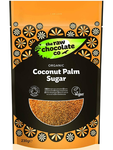 | | Coconut Sugar is known by many names, including coconut palm sugar and coconut nectar. It has a low glycemic index (around 35) and is very tasty.
Coconut sugar can be used as a direct substitute for sugar. It is increasingly being used in many commercially-available confectioneries including om bars.
Use coconut sugar in your tea or coffee, in cakes, biscuits or other baking recipes, or in making desserts or chocolates. More Info > |
|
| 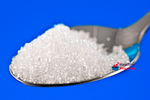 | | Xylitol is a natural sugar-based sweetener that was discovered in Europe in the 19th century. It is typically made from birch sap, and is actually a form of crystalline sugar alcohol. Xylitol has an incredibly low glycemic index - around 7 - and in addition, has two-thirds of the calories of sugar.
Xylitol can be used as a direct substitute for sugar. It comes in the form of a white, crystalline powder that looks and behaves very much like sugar. It can be used in tea or coffee, baking recipes including cakes, biscuits and cookies, and sweets and desserts. We have even used a spice grinder to blend xylitol into a fine powder, and used it as icing sugar. Xylitol is very versatile!
Xylitol is kind to teeth, and is now commonly used to sweeten chewing gums. More Info > |
|
| 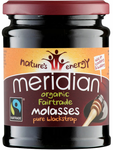 | | Molasses is an unrefined sweetener, typically left over when the white sugar crystals are extracted from sugar cane. It is commonly used in baking, as a healthy alternative to sugar.
Molasses has quite a low GI (around 55). Of all the types of molasses, blackstrap molasses is considered the most nutritious, containing a generally high range of vitamins and minerals including iron, calcium, magnesium, potassium and vitamin B6. Blackstrap molasses is commonly used as a dietary supplement.
Use blackstrap molasses in cakes, biscuits and confectioneries, instead of using sugar. You can also take blackstrap molasses directly by the spoonful: one teaspoonful per day is a great way of boosting your intake of many essential minerals. More Info > |
|
| 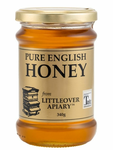 | | Honey is a natural product, produced by bees from nectar. It has been eaten by humans for many thousands of years.
The glycemic index of honey can range enormously, depending on the degree of processing that it has undergone. In general, unrefined honey has a low GI (typically around 30), but many commercial brands can have much higher GIs, and can even contain added sucrose.
Honey has a natural antimicrobial effect. This is due to the presence of glucose oxidase, which slowly releases hydrogen peroxide. For this reason, many people take honey when recovering from illnesses or upset stomachs. Some people even spread honey onto their wounds!
Manuka honey is honey made by bees that take their nectar from the manuka flower. It has a particularly high antibacterial effect. Manuka honey is classified according to its UMF, or "Unique Manuka Factor", which is a measure of the effectiveness of the honey against a given bacterial sample. More Info > |
|
| 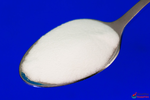 | | Stevia is relatively new to the UK, having been passed by the EU in 2011. Despite this, Stevia has been in use around the world for at least 1500 years. It comes from the leaf the stevia plant. It originated from South America, where it was used in ancient times to sweeten tea, by simply stirring the leaves into the tea, then taking them out again.
Stevia has no calories and is considered to be a natural, safe alternative to things like aspartame or saccharin. It's worth pointing out that although it is sweet, stevia has a different taste to sugar, and it divides opinion. Some people will like it and some people will not! More Info > |
|
| 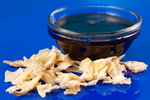 | | Yacon is a natural sweetener. It comes from a root vegetable from Peru similar to a sweet potato, but much sweeter. It comes in the form of flakes or syrup.
Yacon has three main advantages over sugar:
- It has a very low glycemic index (GI). Foods with a high GI release their energy quickly, resulting in an unhealthy blood sugar spike. The lower the GI, the better: whereas glucose has a GI of 100 and table sugar has a GI of 65, Yacon has a GI of just 1! In fact, to some extent, the body ignores the sugars in yacon, so its effective calorific value is very low indeed.
- It contains natural prebiotics. Yacon contains fructo-oligosaccharides which nourish intestinal bacteria.
- It is high in fibre, in both flake and syrup form (about 30% fibre).
More Info > |
|
| 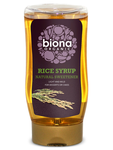 | | Rice Syrup is also known as brown rice syrup, but they are the same thing. It is made by cooking rice, then using natural enzymes to break the starch in the rice into simpler sugars. There has been no reliable research to determine the GI of brown rice syrup.
Brown rice syrup can be used in a similar manner to honey or molasses. More Info > |
|
| 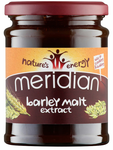 | | Barley Malt Syrup (also known as Barley Malt Extract) is produced by sprouting barley grains in water, generating enzymes that convert the starch in the barley into simpler sugars. The sprouting process is then stopped by drying the grains, usually over a warm fire. The husks of the grain are then removed (and fed to animals), and we are left with a syrup: Barley Malt Syrup.
Barley Malt Syrup has a GI of around 42, which is low enough to be considered quite healthy. It is used in a similar manner to molasses.
Many grains, not just barley, can be "malted" in this way, but barley malt is the most common in this country, and is generally known as just "malt". It is the same type of malt that is used in making beer, malty drinks or malt bread. Malt is considered to be a dietary supplement by many, as it is nutrient-rich. Indeed, many parents used to give their children a teaspoonful of malt every day, before they invented vitamin tablets. More Info > |
|
| 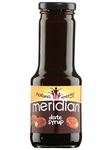 | | Date syrup is typically quite unrefined, and can be extracted from dates using a soaking and squeezing process. For this reason, it is considered healthy, because many of the nutrients are retained, and the resulting sugars are likely to be absorbed slowly into the body. Date syrup has a thick consistency and a rich flavour.
Little is known about the glycemic index of date syrup, but it's likely to be on the lower (good) end of the scale, similar to other syrups.
Date syrup is very commonly used in the Middle East, in numerous desserts. It can be drizzled on ice cream, as well as used in a similar way to any other syrup or molasses. More Info > |
|
| 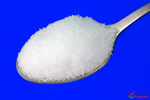 | | Fructose is so-called because it is a sugar commonly found in fruit. It is quite a simple sugar, but has a low glycemic index (approximately 19 or less) which from this perspective makes it a healthy sugar. As an added bonus, fructose is sweeter than sucrose (table sugar), so you don't have to use as much - making that you consume fewer calories for the same sweetness.
Fructose is used as a direct substitute for sugar. In its powdered form, it is most commonly used in tea and coffee. It can also be used in baking, though it has a tendency to caramelise more readily than sucrose, so gives cakes a different taste and texture: usually darker and more moist.
Experts are divided as to whether it's a good idea to consume high quantities of fructose. In particular, many drinks manufacturers tend to stuff their products with high-fructose corn syrup (HFCS), which is a major source of controversy. We still think that excessive sugar consumption is a bad thing, so our advice is to cut sugar consumption in general rather than thinking that fructose is a miracle cure. More Info > |
|
| 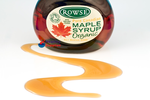 | | Maple syrup is simply the concentrated sap of the maple tree. It is made by making a small cut into the tree, collecting the sap into a bucket, and boiling the sap to evaporate the water. It is considered to have a low glycemic index, similar to molasses (around 54).
Maple syrup is used in a similar manner to honey. It is very commonly used to drizzle over ice cream sundaes, or on toast. It also works in most baking recipes. More Info > |
|
| 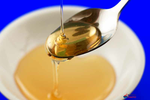 | | Agave Nectar (also known as agave syrup) is made by extracting the sap of the agave plant. It consists mainly of fructose, and therefore has a low glycemic index, which is usually between 20 and 30 depending on the particular processing methods used.
Agave nectar is similar to honey, but is much more runny, and far sweeter. In fact, it is even sweeter than sugar. This means that in addition to its low GI, you need to use less agave nectar than you would sugar - meaning that you consume fewer calories.
Opinion is divided about agave syrup, in the same way that experts disagree about fructose. Because agave syrup contains high levels of fructose, it's thought that excessive consumption can be bad for you, and that you should probably use xylitol in your tea or coffee instead. But some people disagree, and think that agave syrup is really fine and healthy.
Use agave syrup to sweeten baking recipes and desserts, or to spread on toast like honey or drizzle over things. More Info > |
|
| 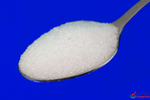 | | Sukrin is produced by fermenting glucose naturally to make erythritol. This happens naturally in many fruits such as pears and melons, as well as mushrooms. The Sukrin range is versatile, and includes a form of icing sugar as well as brown sugar.
Sukrin has a zero GI (which is a good thing) and is kind to teeth. Sukrin is used to sweeten tea and coffee, in baking and to make marzipan. More Info > |
|
Customer Reviews on Trustpilot
Read about how much our customers love Healthy Supplies Holly Knowles I was so excited when my order arrived. The quality of the produce is amazing! I will definitely be ... Iven Yunis This makes a lovely cup of coffee not too strong,(bitter)with a very slite unmistakable undertone o... Shelly-Ann The Friendly Natural tea tree & turmeric soap is a must in our house! Perfect for our skin and multi... Anne wilkinson My spirulina arrived quickly. I’m new to this I use it daily on my cereal
Or in my smoothy loving ... Iven Yunis I just love this cheese it is great for cooking especially when included in an omelette.
Also great ... |
|